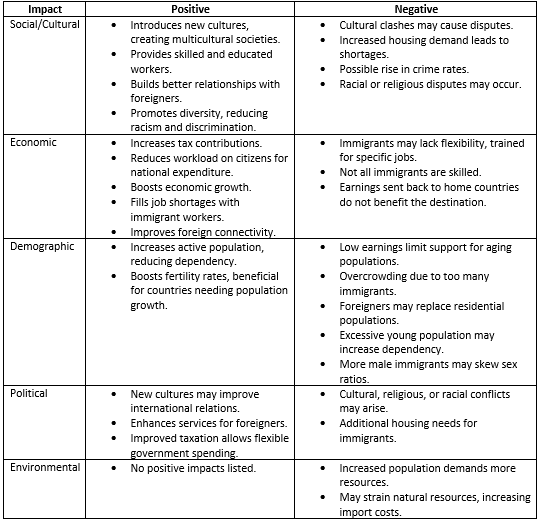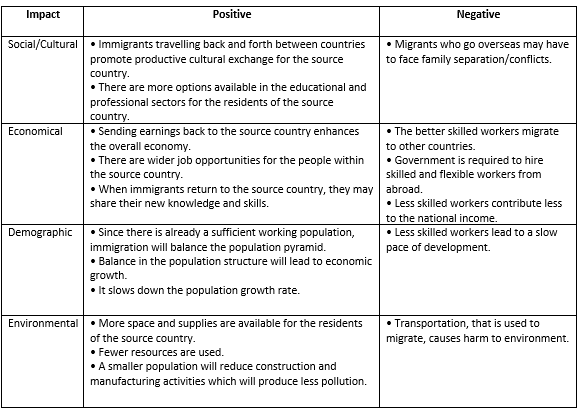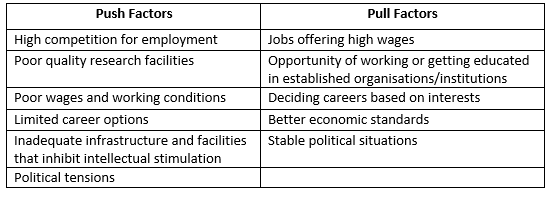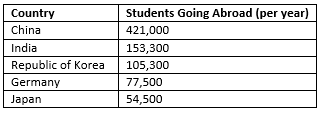Class 8 Exam > Class 8 Notes > Geography Class 8 ICSE > Chapter Notes: Migration
Migration Chapter Notes | Geography Class 8 ICSE PDF Download
| Table of contents |

|
| Introduction |

|
| Human Migration |

|
| Immigration and Emigration |

|
| Why Do People Migrate? |

|
| Types of Migration |

|
| Impact of Migration |

|
| Brain Drain |

|
Introduction
Migration means the movement of people from one place to another to live there for some time or permanently. It has been happening for a long time in history because of many reasons like wars, natural disasters, or the search for better jobs and living conditions. This chapter explains why people migrate, the different types of migration, and how it affects the places they leave and the places they go to. It also talks about the challenges migrants face and the impact of migration on countries around the world.Human Migration
- Migration is when people move from one place to another to live there for a short time or forever.
- People may move within their own country or to a different country.
- Some move for a short period, while others settle in the new place for a long time.
- Migration can happen between villages, cities, or even between countries.
- History shows that migration is not new; it has been happening for many years.
- People have moved because of wars or tough situations in their home areas.
- For example, many moved from Asia to places like North and South America long ago.
- Large-scale migrations have happened in history, like during specific events or tough times.
- In recent years, about 50 million people left Europe for countries like the USA, Canada, Argentina, Australia, New Zealand, and South Africa due to various reasons.
Immigration and Emigration
- Immigration is when someone moves into a country to live there permanently.
- Emigration is when someone leaves their country to live in another country permanently.
- Both immigration and emigration are part of migration, but they are in opposite directions.
- People move because they want better jobs, education, or to escape conflicts or wars.
- For example, the former laws on migration and conflicts often forced people to leave their countries.
- Countries that receive migrants are very careful about who they allow to enter.
Why Do People Migrate?
There are m any economic, social and physical reasons for people to migrate. They can usually be classified into push and pull factors.- Push factors are associated with the area of origin.
- Pull factors are associated with the destination.
Economic Reasons
Pull Factors- People are drawn to places with better job opportunities.
- They want to learn new skills or earn higher wages.
Push Factors
- Economic push factors tend to be almost the exact reversal of the pull factors:
- Overpopulation
- Few job opportunities
- Prevalence of low wages
- This lack of economic opportunities tends to push people to look for their future outside the area of their origin.
- For example, the United States and Canada have been especially prominent destinations for migrants looking for jobs.
- Forced migration has also been used for economic gain, such as the approximately twelve million men, women and children who were forcibly carried as slaves to the Americas between the 16th and 18th centuries.
Social Reasons
Pull Factors- Religious tolerance
Push Factors
- Intolerance towards a certain cultural group
- Active religious persecution—Examples being the Huguenots in the 16th century France, the Puritans in the 17th century England, and the Jewish communities from Nazi Germany
Physical Reasons
Pull Factors- Attractive environments such as mountains, sea sides and warm climates, for example, the Alps attracting people to eastern France.
Push Factors
- Natural disasters — For example, six million people fled Mozambique as a result of famine, civil war and flooding.
Types of Migration
Migration can be of different types based on where and why people move:- Migration types depend on the flow, number of people, reasons, duration, and nature of movement.
- Immigrants are people who move into another country.
- Intercontinental Migration: Movement across continents, e.g., from Korea (Asia) to Brazil (South America).
- Intracontinental Migration: Movement within the same continent.
- Regional/Internal Migration: Movement within the same region, continent, or country.
- Rural-Urban Migration: Movement from rural areas to urban areas in the same country for better opportunities and lifestyles.
- Forced/Involuntary Migration: Migration enforced by government or authorities for specific reasons.
- Impelled Migration: Migration due to push factors like war or hunger, though not forced.
- Periodic/Seasonal Migration: Temporary movement for work during specific seasons, e.g., crop harvesting.
- Return Migration: Voluntary return to the original place of residence after the reasons for migration no longer exist, e.g., retirees returning to hometowns.
- Long and Short-Term Migration:
- Long-term migration for threatening conditions, e.g., better healthcare access.
- Short-term migration, e.g., studying abroad temporarily before returning home.
- Interstate Migration: Movement from one state or province to another within a country, common due to favorable laws.
- Urban-Urban Migration: Movement from one urban area to another, often due to job transfers or better opportunities.
- Urban-Rural Migration: Movement from urban to rural areas for peace and tranquility, more common in developed nations like the USA.
Fact Corner
- From 1858 to 1947, India was under British rule.
- After the 1947 partition, India split into India and Pakistan, triggering mass migration.
- Muslims migrated to West and East Pakistan (now Bangladesh), while Hindus and Sikhs moved to India.
- Violent attacks occurred, and thousands were killed by the end of migration in 1948.
Impact of Migration
Migration affects both the destination and source countries socially, culturally, economically, demographically, and environmentally.Impacts on Destination Country:

Impacts of Migration on the Source Country:

Brain Drain
- Brain drain is when skilled and educated professionals leave their country for better opportunities elsewhere.
- It deprives the source country of talent, benefiting the destination country’s economy.
- Involves the loss of academic and technological labor to more favorable environments.
- Common from developing to developed countries.
Main Characteristics of Brain Drain
- Skilled professionals like engineers, doctors, and scientists move for better opportunities.
- Higher movement from developing to developed countries due to better prospects.
- Better educational systems and infrastructure attract students and professionals.
Causes of Brain Drain:

Countries with the Highest Brain Drain:

Brain Drain in India
- India loses skilled professionals like doctors, engineers, and scientists to countries like Canada, Germany, USA, and the UK.
- Students studying abroad often stay and work there, contributing to brain drain.
Impacts of Brain Drain
Positive Impacts:- Migrants’ earnings sent back home boost economic growth.
- Improves living standards for migrants’ families.
- Migrants return with new skills and knowledge.
- Professionals fulfill ambitions abroad.
Negative Impacts:
- Economic losses due to reduced employment and wages.
- Slow industrial development.
- Shortage of competent professionals.
- Loss of investment in education as benefits go to destination countries.
The document Migration Chapter Notes | Geography Class 8 ICSE is a part of the Class 8 Course Geography Class 8 ICSE.
All you need of Class 8 at this link: Class 8
|
11 videos|41 docs|10 tests
|
FAQs on Migration Chapter Notes - Geography Class 8 ICSE
| 1. What is the difference between immigration and emigration? |  |
Ans.Immigration refers to the act of coming into a new country to live permanently, while emigration is the act of leaving one’s country to live in another. Essentially, immigration focuses on entering a new country, whereas emigration focuses on leaving one’s home country.
| 2. Why do people migrate? |  |
Ans.People migrate for various reasons, including economic opportunities, better living conditions, education, escape from conflict or persecution, and family reunification. These factors influence their decision to seek a new place to live.
| 3. What are the different types of migration? |  |
Ans.The different types of migration include internal migration (moving within a country), international migration (moving to a different country), voluntary migration (moving by choice), and forced migration (due to factors like war or natural disasters). Each type presents unique challenges and experiences for migrants.
| 4. How does migration impact both the home and host countries? |  |
Ans.Migration can have significant impacts on both home and host countries. Home countries may experience a brain drain, where skilled workers leave, affecting their economy and development. Host countries may benefit from the skills and labor of immigrants, contributing to economic growth but may also face challenges related to integration and resource allocation.
| 5. What is brain drain, and why is it a concern? |  |
Ans.Brain drain is the emigration of highly skilled or educated individuals from one country to another, often for better opportunities. It is a concern because it can lead to a shortage of talent in the home country, hindering its development and progress, while benefiting the host country with a skilled workforce.
Related Searches















